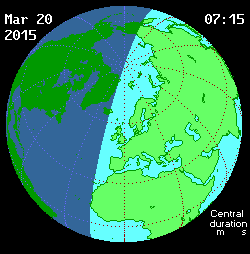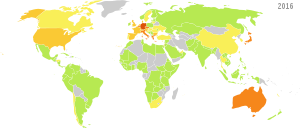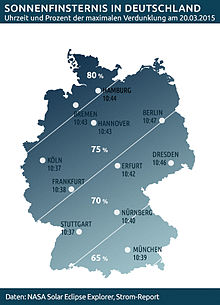Solar eclipse of March 20, 2015
| Solar eclipse of March 20, 2015 | |
|---|---|
 Animation of the shadow path of the solar eclipse on March 20, 2015 |
|
| classification | |
| Type | Total |
| area |
Greenland , Iceland , Europe , North Africa , North Asia Total: North Atlantic , Faroe Islands , Svalbard |
| Saros cycle | 120 (61 of 71) |
| Gamma value | 0.9454 |
| Greatest eclipse | |
| Duration | 2 minutes 47 seconds |
| place | North Atlantic , east of Iceland |
| location | 64 ° 26 ' N , 6 ° 39' E |
| time | March 20, 2015 09:45:39 UT |
| size | 1.0446 |

The total solar eclipse of March 20, 2015 occurred on the day of the beginning of spring in the northern hemisphere. The total eclipse began east of Newfoundland , the shadow path then framed Greenland and Iceland on its way through the European Arctic Ocean . The Faroe Islands and Svalbard were in the total zone. The eclipse ended near the North Pole , exactly on the day on which the sun appeared over the horizon for the first time in six months. In its partial phase, the darkness could be seen from all of Europe.
The path of the umbra was wide throughout the course of more than 400 kilometers, the maximum width was 487 kilometers. This width of the shadow path, which is unusually large for total solar eclipses, resulted from the fact that the sun was nowhere higher than 18 ° when totality entered, which resulted in long shadows on the earth's surface.
course
The umbra of the Moon hit the Earth the first time at 9:14 UT ( Universal Time ) in the North Atlantic east of Newfoundland at the site 53 ° 38 ' N , 45 ° 59' W . The eclipse that took place there during sunrise lasted 2 minutes and 6 seconds. The umbra, initially 406 kilometers wide, sped from there in a northeasterly direction across the Atlantic, between Iceland and the British Isles. He first met land on the Faroe Islands . The totality there takes at least 2 minutes, depending on the location, up to 2 minutes and 20 seconds. A little later, the maximum of the eclipse occurred in the Atlantic east of Iceland at 9: 35.38 UT, the total duration there was 2 minutes and 47 seconds, the width of the shadow path had increased to 463 kilometers. Then the umbra swept over Spitzbergen , where in Longyearbyen a total of 2 minutes and 28 seconds could be observed. The umbra path then continued across the European Arctic Ocean towards the North Pole. Only 69 kilometers from the North Pole, the umbra left Earth at 10:21 UT.
The partial phase of the eclipse was seen from Europe, North Africa, western and northern Asia, and Greenland. In Central Europe the degree of coverage was between 60 and 85 percent, although it was greater in the northwest than in the southeast. In Bern , the eclipse began at 9:24 am CET ( Central European Time ) and ended at 11:44 am CET, with a maximum of 69.5 percent of the solar disk being covered at 10:32 am CET. In Vienna the solar eclipse began at 9:37 CET, around 13 minutes later, and ended at 11:57 CET. The greatest eclipse was observed at 10:45 am CET. About a minute later, at 9:38 CET, it started in Berlin and ended at 11:58 CET. Here the cover was greatest at 10:47 CET. The degree of coverage in Vienna was 62.9 percent, while in Berlin it reached 74.2 percent. The largest coverage in Germany was at the elbow near List on Sylt with 83.1 percent. From the point of view of a beholder, the moon moved from the right to the left edge of the sun in the course of the eclipse and covered a correspondingly large, upper part of the solar disk.
Impressions
Solar eclipse in Markt Schwaben near Munich
Observation in the Brno Planetarium
Timelapse video of the solar eclipse, recorded in Mindelheim (near Munich)
Influence on solar power generation and network load control

In the run-up to the solar eclipse, some media feared that the stability of the power supply could be jeopardized by the collapse in solar power generation during the eclipse and the rapid increase in feed-in after the eclipse. The reason for this is the significantly greater power gradient compared to days with normal solar power feed-in , i.e. H. the higher rate of decrease or increase in performance.
Scientific studies, however, did not see the solar eclipse as a threat to the power grid. So calculated z. For example, a study by the University of Applied Sciences in Berlin in October 2014 showed a power gradient (decrease or increase in electrical output over time) of a maximum of 52 MW / min ( megawatts per minute) when the sky is cloudy , while −272 MW / min and +348 MW / min are possible, which corresponds to 3.5 times the usual power gradients of all photovoltaic systems in Germany. A study commissioned by the Association of European Transmission System Operators (ENTSO-E) found slightly higher values for the maximum possible power gradients and named −400 MW / min and +700 MW / min.
This increase in the residual load can, according to Less et al. can be absorbed by the pumped storage power plants alone . In addition, flexible power plants, such as gas-fired power plants that can be regulated quickly , could help compensate. Furthermore, compensatory measures on the demand side would also be possible, so-called load control measures . However, the effects of the solar eclipse to be expected according to the predicted cloud situation would have to be considered in the electricity demand planning in advance.
In fact, solar power output during the solar eclipse was at the high end of the forecast; the solar eclipse could be managed as forecast without failures. Additional reserve capacities were ordered in advance and power plant failures were taken into account. Load control measures had also been agreed as an additional safety measure, so that at the height of the blackout, aluminum producers, among others, cut their production for which they received remuneration. The control energy was only needed to a manageable extent. The costs for the reserve capacities ordered as a precaution (3.5 million euros) corresponded to around a third of the additional costs that can arise in a hurricane (10 million euros). The electricity market also worked and fluctuated between high prices and negative electricity prices (when a lot of solar power returned).
The solar eclipse was also seen as a test case for the energy transition , as the continued strong expansion of fluctuating renewable energies, photovoltaics and wind energy, will lead to more frequent fluctuations in electricity generation in the future. B. If there is a strong wind in the morning with a cloudless sky or the wind dies down in the afternoon. The measures taken by the network operators to ensure network stability, even when maximum fluctuations occur due to the solar eclipse described here, provided valuable information for future flexibility requirements for the electricity network. An investigation carried out after the eclipse on the basis of real data showed that the possible effects of the eclipse could be predicted very precisely in advance and the network security was not endangered even in a worst-case scenario. In fact, the network frequency remained clearly within manageable limits. However, the power gradients of photovoltaic systems were at least a factor of 2 higher than on a normal day.

Dealing in school
Friday, March 20, 2015, was a regular school day, so schooling was compulsory during the darkness. Due to the description of the dangers involved in dealing with solar eclipses, which can only be understood by experts, for example by the Ministry of Education in North Rhine-Westphalia , there were a wide range of decisions regarding the observation options for schoolchildren. Often, however, children had to stay in school buildings. This caused considerable resentment in the science-oriented parts of society about the state of Germany as an educational location.
Classification of darkness
The eclipse was the 61st of 71 solar eclipses of the Saros cycle with the number 120. All eclipses of this cycle take place when the moon passes its descending lunar node . The cycle began with the eclipse of May 27, 933 with a partial eclipse in which the shadow of the moon grazed the south pole . During the following eclipses of the cycle, the shadow moved further and further north; during the last eclipse on July 7, 2195, it will only touch the North Pole. The eclipse of 2015 was the penultimate total of the cycle, only in the subsequent eclipse of March 30, 2033 the new moon disc will completely cover the sun.
The following solar eclipses
The second solar eclipse of 2015 occurred on September 13th . It was only partially and therefore nowhere on earth as ring-shaped or totally observable. It could be seen from southern Africa , the southern Indian Ocean and Antarctica . The following central eclipse was seen on March 9, 2016 . During this total solar eclipse, the umbra moved over Sumatra , Borneo and Sulawesi . The partial phase of the solar eclipse of August 21, 2017 could only be seen in Western Europe. The next eclipse to be seen from Central Europe will not come until June 10, 2021 . This ring-shaped darkness can only be partially seen from there.
Trivia
The Faroese band Hamferð recorded a music video about the totality in which the singer and the two guitarists of the band can be seen with the darkness in the background.
literature
- Hans-Ulrich Keller (Ed.): Kosmos Himmelsjahr 2015. Franckh-Kosmos, Stuttgart 2014, ISBN 978-3-440-14025-3 .
- Wolfgang Held: Solar and lunar eclipses and the most important astronomical constellations up to 2017. Verlag Freies Geistesleben, Stuttgart 2005, ISBN 3-7725-2231-9 .
- Hans-Ulrich Keller (Ed.): Kosmos Himmelsjahr 2009 . Franckh-Kosmos, Stuttgart 2008, ISBN 978-3-440-11350-9 .
- Sven Killinger et al .: Impact of the Solar Eclipse from 20th March 2015 on the German Electrical Supply — Simulation and Analysis . In: Energy Technology . tape 4 , 2016, p. 288–297 , doi : 10.1002 / duck.201500228 .
Individual evidence
- ↑ Fred Espenak: Path of Total Solar Eclipse of 2015 Mar 20. Retrieved February 11, 2015.
- ↑ a b c Keller (ed.): Kosmos Himmelsjahr 2015. pp. 86–94, see literature
- ↑ Solar eclipse 2015: time and extent of maximum eclipse.Retrieved on March 22, 2015
- ↑ Fred Espenak: Total Solar Eclipse of 2015 Mar 20. Google Maps and Solar Eclipse Paths. Retrieved March 18, 2015.
- ↑ Ranga Yogeshwar , A Mainstream of Scaremongering . In: Frankfurter Allgemeine Zeitung , March 20, 2015. Retrieved March 22, 2015.
- ↑ a b c Johannes Less, Joseph Bergner, Tjarko Tjaden, Volker Quaschning: Influence of the solar eclipse in March 2015 on solar power generation in Germany. Berlin University of Technology and Economics, Berlin 2014, doi: 10.13140 / 2.1.5190.4963 (online)
- ↑ Solar eclipse on March 20, 2015 - Effects on the system stability of the German power supply ( Memento of the original from March 17, 2015 in the Internet Archive ) Info: The archive link was automatically inserted and not yet checked. Please check the original and archive link according to the instructions and then remove this notice. . Fraunhofer ISE website. Retrieved March 22, 2015.
- ↑ ENTSO-E : Solar Eclipse 2015 - Impact Analysis. P. 3, 6, 7, 13, February 19, 2015, accessed March 18, 2015.
- ↑ APA: The power grid can handle solar eclipse failures without any problems. In: futurezone.at. March 20, 2015, accessed March 21, 2015 .
- ↑ Agora Energiewende (2015): Die Sonnenfinsternis 2015: Preview of the power system 2030. Challenges for the power supply in systems with high proportions of wind and solar energy. ( Memento of the original from March 26, 2015 in the Internet Archive ) Info: The archive link was inserted automatically and has not yet been checked. Please check the original and archive link according to the instructions and then remove this notice.
- ^ A b Sven Killinger et al .: Impact of the Solar Eclipse from 20th March 2015 on the German Electrical Supply — Simulation and Analysis . In: Energy Technology . tape 4 , 2016, p. 288–297 , doi : 10.1002 / duck.201500228 .
- ↑ Education portal North Rhine-Westphalia: Partial solar eclipse on March 20 ( memento of the original from November 19, 2015 in the Internet Archive ) Info: The archive link was inserted automatically and has not yet been checked. Please check the original and archive link according to the instructions and then remove this notice.
- ↑ WDR-Aktuell Partial solar eclipse in NRW: When it gets darker in the school yard ( Memento from March 15, 2015 in the Internet Archive )
- ↑ Spectrum of science: The solar eclipse 2015: Opportunity seized - opportunity wasted
Web links
- solar-eclipse.de: The total solar eclipse from May 20th, 2015
- sofi2015.de - Extensive information about the solar eclipse on March 20, 2015
- NASA: Total Solar Eclipse of 2015 March 20
- Solar Eclipses of Saros 120
- Astro Corner: March 20, 2015 - Total solar eclipse
- ENTSO-E : 20 March Solar Eclipse: An Unprecedented Test for Europe's Electricity System
- Spectrum of science : Partial solar eclipse - Dark minutes for electricity suppliers
- DLR : On March 20th: Solar eclipse!











